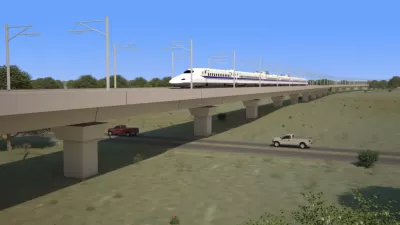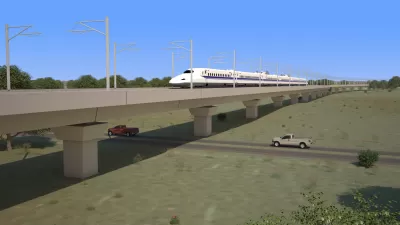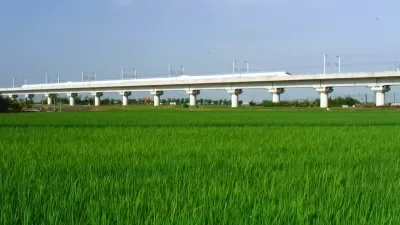The latest plan for the Texas Central high-speed rail line would stop trains well short of downtown Houston. Transit advocates are displeased with the change of plans.
"The area around U.S. 290 and Loop 610, anchored by Northwest Mall, is likely to be the end of the line for a proposed Houston-to-Dallas high-speed passenger train," reports Dug Begley. The implication there is that the proposed high-speed rail line will not come into downtown Houston, as once considered as a possibility.
"The Federal Railroad Administration has eliminated from consideration both paths that would have carried the trains to Houston's central business district," according to Begley. The decision not to bring the route into downtown is justified for the cost savings associated with avoiding the density and infrastructure in the downtown area. Begley surveys local voices on either side of the issue of bringing the trains into downtown, and also notes that the new "landing zone" for the line will likely provide a catalyst for growth in the Northwest Mall area.
Count Eric Jaffe of CityLab as one of the supporters of bringing the train into downtown. He wrote a column that describes the Federal Railroad Administration's decision to stop the route short of downtown a "troubling step back" after months of positive news.
Here, Jaffe lists some of the reasons why a downtown route might be preferable:
- "For one thing, it means HSR riders will have to connect to another mode of transportation to reach downtown Houston. At the moment, though, no such connection exists."
- "More broadly, conventional wisdom holds that HSR stations function better for city residents when they’re located downtown. That point was emphasized in a recent report by Eric Eidlin of the U.S. Federal Transit Administration on best practices from around the world."
FULL STORY: Planned high-speed rail line won't come downtown

Maui's Vacation Rental Debate Turns Ugly
Verbal attacks, misinformation campaigns and fistfights plague a high-stakes debate to convert thousands of vacation rentals into long-term housing.

Planetizen Federal Action Tracker
A weekly monitor of how Trump’s orders and actions are impacting planners and planning in America.

San Francisco Suspends Traffic Calming Amidst Record Deaths
Citing “a challenging fiscal landscape,” the city will cease the program on the heels of 42 traffic deaths, including 24 pedestrians.

Defunct Pittsburgh Power Plant to Become Residential Tower
A decommissioned steam heat plant will be redeveloped into almost 100 affordable housing units.

Trump Prompts Restructuring of Transportation Research Board in “Unprecedented Overreach”
The TRB has eliminated more than half of its committees including those focused on climate, equity, and cities.

Amtrak Rolls Out New Orleans to Alabama “Mardi Gras” Train
The new service will operate morning and evening departures between Mobile and New Orleans.
Urban Design for Planners 1: Software Tools
This six-course series explores essential urban design concepts using open source software and equips planners with the tools they need to participate fully in the urban design process.
Planning for Universal Design
Learn the tools for implementing Universal Design in planning regulations.
Heyer Gruel & Associates PA
JM Goldson LLC
Custer County Colorado
City of Camden Redevelopment Agency
City of Astoria
Transportation Research & Education Center (TREC) at Portland State University
Jefferson Parish Government
Camden Redevelopment Agency
City of Claremont





























